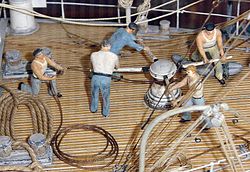
A capstan is a vertical-axled rotating machine developed for use on sailing ships to apply force to ropes, cables, and hawsers. The principle is similar to that of the windlass, which has a horizontal axle.
The word, connected with the Old French capestan or cabestan(t), from Old Provençal cabestan, from capestre "pulley cord," from Latin capistrum, -a halter, from capere, to take hold of, seems to have come into English (14th century) from Portuguese or Spanish shipmen at the time of the Crusades.
In its earliest form, the capstan consisted of a timber mounted vertically through a vessel's structure which was free to rotate. Levers, known as bars, were inserted through holes at the top of the timber and used to turn the capstan. A rope wrapped several turns around the drum was thus hauled upon. A rudimentary ratchet was provided to hold the tension. The ropes were always wound in a clockwise direction (seen from above).
Capstans evolved to consist of a wooden drum or barrel mounted on an iron axle. Two barrels on a common axle were used frequently to allow men on two decks to apply force to the bars. Later capstans were made entirely of iron, with gearing in the head providing a mechanical advantage when the bars were pushed counterclockwise. One form of capstan was connected by a shaft and gears to an anchor windlass on the deck below. On riverine vessels, the capstan was sometimes cranked by steam power.